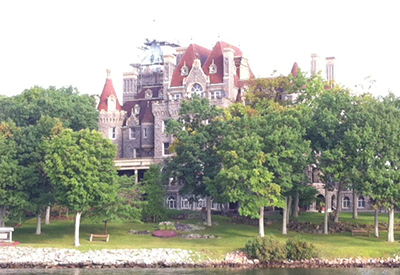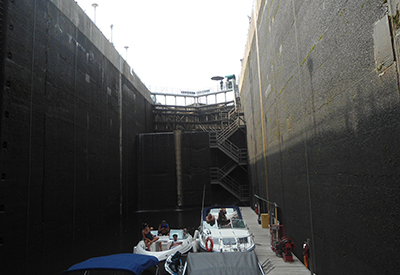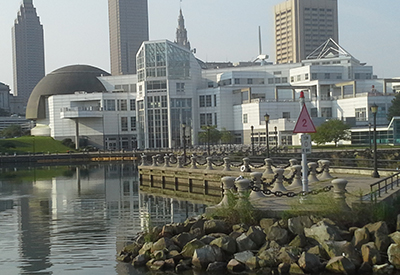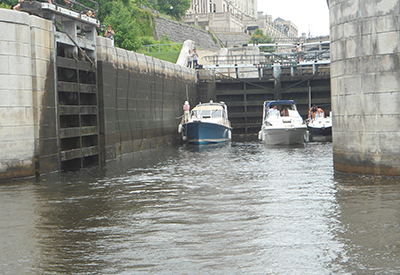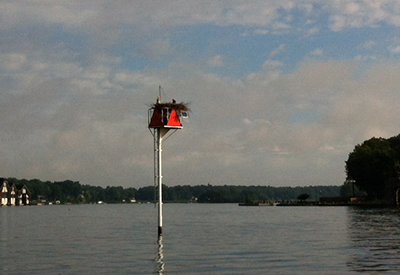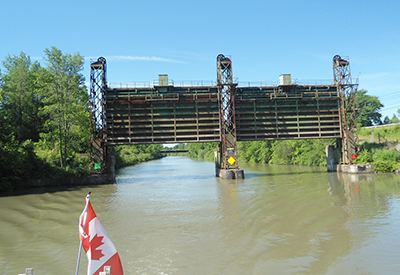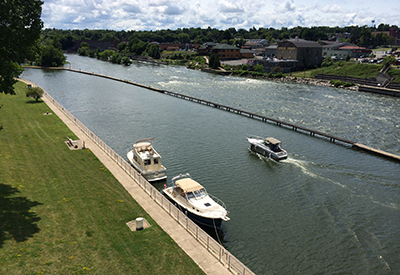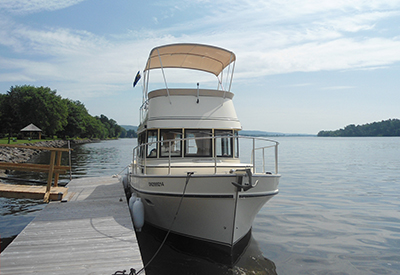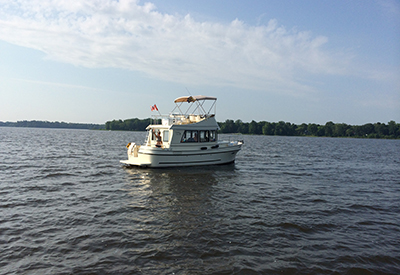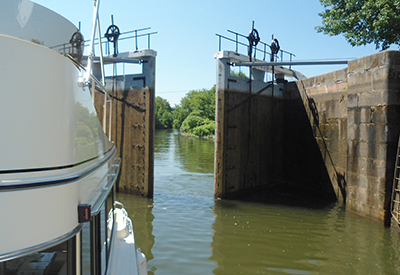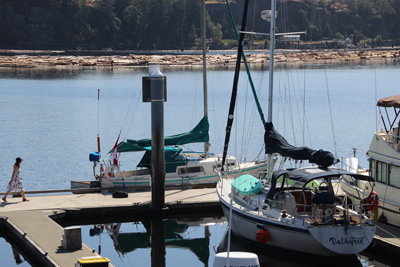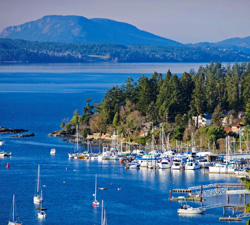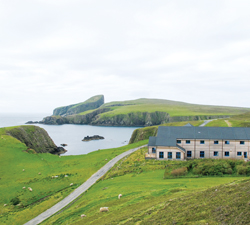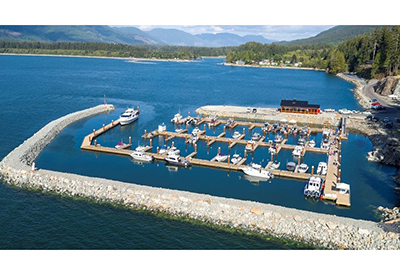A Cruising Adventure Through New York’s Canals

Maurice and Hélène Marwood and Terry and Linda Hilts
The sun was just starting to light up the horizon when we departed our home slips in Crystal Harbour, LaSalle, Ontario, and entered the Detroit River. It was June 28, 2014, the first day of our adventure to explore the waters of the Great Lakes and beyond from Windsor to Montreal. We had set aside about six weeks to cruise down Lake Erie and enter the NY Canal System near Buffalo, travel east on the canal to Oswego, head straight north across Lake Ontario to Kingston, traverse the Rideau Canal to Ottawa, cruise down the Ottawa River to Montreal, head back west up the St. Lawrence River to the Thousand Islands, and finally re-enter the NY Canal system at Oswego and follow it back toward Lake Erie and home.
My wife, Hélène, and I travelled on Mystic Blue, a Mainship Pilot Classic. Terry and his wife, Linda, voyaged on their Camano Troll, 4 Buoys. Both 30-foot vessels were designed to cruise at a comfortable and economical speed of about 8 – 9 knots.
We knew the first day would be a long cruise to reach our first stop at Erieau. Fortunately, the water on Lake Erie was relatively flat and, as a bonus, we enjoyed a light westerly wind on the stern. We knew the journey included relatively long stretches of open water, so we hoped the good weather window would continue. We skipped down the Canadian shore of Lake Erie, stopping at Port Stanley and Port Dover. Due to exceptionally high winds and waves on the lake we were forced to spend two days at Port Dover. It was very enjoyable celebrating Canada Day with friendly boaters at the Port Dover Yacht Club.
The next morning the wind and waves had calmed, so we departed Port Dover early for the long cruise to the entrance of the Erie Canal at Tonawanda, NY. We wanted to devote most of the time enjoying the canal systems, so when the weather permitted we spent longer days while travelling on open water. After a nine hour cruise (68 nautical miles) we arrived on schedule and decided to take a day of R&R in Tonawanda before embarking on the journey to explore the Erie Canal—affectionately called “The Ditch.”
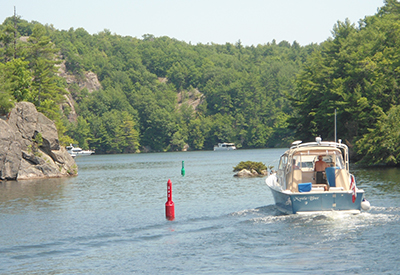
The Canal was completed in 1825 and connected Lake Erie to the Hudson River. Its original purpose was to allow commercial products from the west to be easily and cheaply transported to the heavily populated eastern seaboard. It is now almost exclusively used by pleasure craft. In year-2000, the Canal was established as the National Heritage Corridor.
Our average speed on the canal was only about 5 knots and we cruised for about 4 to 5 hours each day. This gave us most of the afternoons to relax and explore the many small towns and villages scattered along the route. It was a pleasure to experience the boater-friendly communities that often provided free dockage and full services at municipal docks near downtown close to local museums, points of interest, numerous shops, restaurants and parks along the water’s edge. We like to enjoy the ambiance and the festivities at the numerous Irish Pubs along the way. And a highlight was a wonderful dinner at Mr. Dominic’s restaurant located at the historic Green Lantern Inn in Fairport, NY; definitely worth a stop.
We arrived at Oswego, NY, after spending 6 days on the Canal traversing 20 locks, 16 lift bridges and traveling 224 nautical miles (258 statute miles). The previous summer we had completed the entire Trent-Severn Canal system so we were not naive when it came to dealing with locks. (Refer Canadian Yachting Magazine, March 2014, digital version available at www.CanadianYachting.ca).
We encountered some rain and a few thunderstorms; however, overall the weather was very nice. While on the canal the wind and rain posed no threat and the storms usually arrived late in the afternoon after we had already moored for the night.
The day after arriving in Oswego the weather was exceptionally good; Lake Ontario was perfectly flat for the 48 nautical mile leg straight north to Kingston. It was a very enjoyable five hour cruise across the open water of Lake Ontario, and we arrived early afternoon at Confederation Basin, Kingston’s municipal marina, where we spent the night. Since we had read good stories about the Rideau during our preparations, the next morning we eagerly embarked Kingston and entered the Canal on the Cataraqui River.
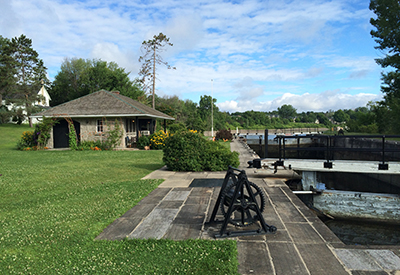
The Rideau Canal first opened in 1832 in preparation for a possible war with the United States, and served as a secure supply and communications route between Montreal and the British naval base in Kingston, bypassing the stretch of the St. Lawrence River bordering New York. It is the oldest continuously operated canal system in North America, and was registered as a UNESCO World Heritage Site in 2007. It also became an important commercial artery, but today is used primarily for pleasure boating. The waterway is home to many species of birds, mammals, reptiles and fish. Highlights of the Rideau included Morton Bay, where we anchored for the night, Westport, Smith Falls and Merricksville. Usually, we moored at municipal docks because the lock walls were not very inviting, especially compared to the Trent-Severn system.
From Kingston to Ottawa, the Rideau Canal has 36 locks spread over only 94 nautical miles. Consequently, the run between the locks is short, and considerable time was spent transiting the locks, which detracted significantly from the time available to relax and enjoy the cruise. To further complicate matters, the tops of the lock walls are often only inches below the top of the lock walls after the lock has been filled, making the fenders protecting the boat almost useless.
During a “senior moment” the Captain of Mystic Blue failed to open the main seacock after checking the strainer for weeds. The next morning the engine temperature alarms soon screamed at us, creating a brief period of anxiety. After limping for about 20 miles to a marina, the main sea water impeller was changed along with the oil, and we proceeded on our way with no serious consequences. The impeller was completely destroyed due to lack of water. It was a learning experience!
It was quite common to go through the locks with other boaters, and we became friends with the crew of M/V Michellekee and stayed with them all the way to Montreal and up the St. Lawrence to their home in Alexandrea Bay. We shared many experiences and good times with them along the route. In all our years of cruising we have found boaters to be the friendliest of people, willing to help and share a wealth of good and useful information.
We arrived at Ottawa after spending seven days on the Canal and looked forward to staying put for a couple of days to relax and explore the city. We moored at the side of the Canal right downtown near the Wellington Street fixed bridge. Unfortunately, Ottawa was not very boater-friendly. Unlike most other municipal docks, it offered no water, washrooms, showers, and pump-out or fuel facilities. Besides that it was quite expensive to moor, especially considering the lack of facilities. This was very surprising given that it was the nation’s capital and hundreds of boaters pass though Ottawa every year.
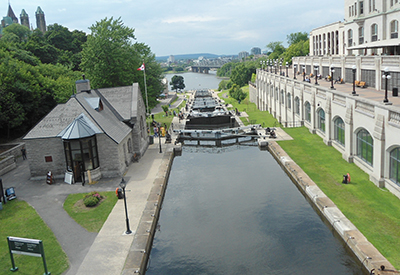
The nation’s Capital is always a pleasant place to visit and we enjoyed the famous ByWard Market with its museums, cafés, specialty shops, boutiques, galleries, restaurants, pubs and more. The ByWard Market was established by Lt-Col. John By in 1826 and is one of Canada’s oldest and largest public markets. We also enjoyed the impressive nighttime light show at the Parliament Buildings.
Originally, we had intended on cruising the Rideau Canal in both directions; however, having navigated 36 locks in the short distance from Kingston to Ottawa, we decided instead, to proceed to Montreal on the Ottawa River and return westward on the St. Lawrence River. This avoided a repeat of the numerous locks on the Rideau Canal.
In order to pass through the City of Kingston and complete the Rideau Canal we had to negotiate a series of eight staircase locks. Once we started down these locks we had to go all the way to the bottom—a drop of 79 feet. These locks are very close to the Parliament buildings and many tourists stand to watch the operation. It happened to be the beginning of the obligatory Quebec construction holiday and the locks were very busy. Consequently, we had to wait about seven hours to enter, and it took us about two hours to transit this very fascinating series of locks.
As it turned out, we were exceedingly happy with the decision to cruise the Ottawa River. It was a very pleasurable experience not to be missed—the constantly changing scenery, the many points of interest, and the wildlife. In addition, there were only two locks to negotiate and we were helped along by a favourable 1-knot current.
We enjoyed a wonderful visit to the Fairmont Le Chateau Montebello, reputedly the largest log chateau in the world. The second day on the river we arrived at the Carillon Lock that drops boaters 65 feet. It is very unusual in that the exit gate is lifted over the entrance and the vessel passes under it to exit the lock.
On the third day we negotiated the lock at Saint-Anne-de-Bellevue and proceeded to the full service marina at Lachine, QC, where we stayed for the night. A very pleasant dinner was enjoyed outdoors on the picnic table with some family members and friends from Montreal.
The river cruise had finally come to an end. We had reached the eastern end of the route, and now looked forward to heading westward up the St. Lawrence River. Unfortunately, it would be against a significant unfavorable current that varied between 1 and 2 knots.
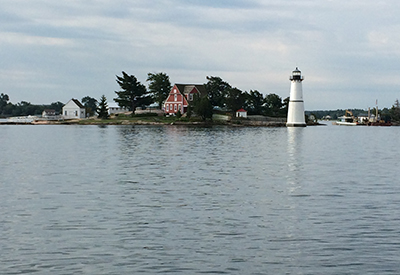
The next day the weather forecast was threatening. Nevertheless, we decided to continue, hoping the worst of the weather would hold off until late in the afternoon, as usual. That was not to be—a serious thunderstorm arrived shortly after we embarked. For about an hour we struggled with high winds, very heavy rain, lightning and very poor visibility. Fortunately, it did not last long; the weather cleared and we navigated two large St. Lawrence Seaway locks and finally moored safely that night at Valleyfield Marina.
The remainder of the cruise up the St. Lawrence was uneventful as we negotiated three more St. Lawrence Seaway locks—the Snell Lock, the Eisenhower Lock, and the Iroquois Lock. Stops at Brockville, Alexandria Bay, Clayton, and Sacket’s Harbour were all very interesting. Of course, we saw the Boldt Castle and enjoyed cruising through the Thousand Islands with its outstanding scenery and environment. The Antique Boat Museum at Clayton was a highlight and we would encourage a visit if you are in the area.
We were now into our 29th day of the cruise and it was time to head back across Lake Ontario to enter the Erie Canal once again at Oswego. The next seven days travelling westbound on the Erie Canal was just as enjoyable as the eastbound journey just two weeks earlier. We arrived at Tonawanda and decided we would enjoy a day of downtime for relaxation, and to prepare for the long travel down the southern coast of Lake Erie and home. The weather continued to hold and we were able to travel whenever we chose.
The southern coast of Lake Erie represented all new cruising grounds for us, and we looked forward to stopping at Dunkirk, Erie, Ashtabula, Cleveland, Vermillion, and Put-In-Bay. All of these destinations were very boater-friendly and we would definitely recommend a stop if you are in the region. We especially enjoyed the friendly and modern Erie Yacht Club, and the new North Coast Harbor Marina in downtown Cleveland, colloquially referred to as the Dock and Rock Marina because it was immediately adjacent to the Rock and Roll Hall of Fame and the Science Center. We spent two nights in Cleveland, and dinner at the Chocolate Bar restaurant in downtown was a special experience.
 We arrived home after 45 days on the water just before a serious storm hit Windsor, once again confirming that when cruising on open water one should always leave early and be moored no later than early afternoon in order to avoid bad weather. It is an established rule that we tried to follow religiously—and it worked almost every time.
We arrived home after 45 days on the water just before a serious storm hit Windsor, once again confirming that when cruising on open water one should always leave early and be moored no later than early afternoon in order to avoid bad weather. It is an established rule that we tried to follow religiously—and it worked almost every time.
It was a wonderful cruising adventure in our own backyard; namely, the largest body of fresh water in the world. Take advantage of it, plan a long cruise and make it a highlight of your life’s adventure.
And be sure to take some Safe Boating Courses with the Canadian Power Squadron and travel with confidence.
Photo Captions:
Photo 1 – Waiting to transit the historical lock at Sainte-Anne-de-Bellevue and enter the St. Lawrence River.
Photo 2 – Essential to follow the route. Here we had to pay careful attention and do a sharp port turn through the buoys or hit the rocks.
Photo 3 – The blockhouses on the Rideau Canal are original, and most locks are still manually operated, as designed in 1832.
Photo 4 – Looking down the series of eight step-locks (79’ drop) at the end of the Rideau Canal at Ottawa. At the bottom you can see the Ottawa River. The old original blockhouse on the left is now an interesting museum.
Photo 5 – Typical of several picturesque lighthouses in the Thousand Islands.
Photo 6 – Be sure to stop at the remarkable Antique Boat Museum in Clayton, NY.
All photos (above and below) by Maurice and Hélène Marwood and Terry and Linda Hilts.
